
The launch of mass-market graphics cards is increasingly provoking loud discussions about the compromises made by manufacturers in some models with 8 gigabytes of video memory. That’s why gamers are looking for alternatives that will allow them to not worry about the flimsy frame rate in the coming years on a moderate budget. Today, in our editorial review, we will try to find out if Gigabyte Radeon RX 9060 XT GAMING OC 16G can become a reasonable counterweight to NVIDIA graphics cards.
Content
- 1 Specifications of Gigabyte Radeon RX 9060 XT GAMING OC 16G
- 2 Test bench
- 3 Package, appearance and cooling of Gigabyte Radeon RX 9060 XT GAMING OC 16G
- 4 Performance and architecture
- 5 Gigabyte Radeon RX 9060 XT GAMING OC 16G gaming performance
- 6 Power consumption, noise and heat of the Gigabyte Radeon RX 9060XT GAMING OC 16G
- 7 Experience of use
- 8 Prices and competitors
Specifications of Gigabyte Radeon RX 9060 XT GAMING OC 16G
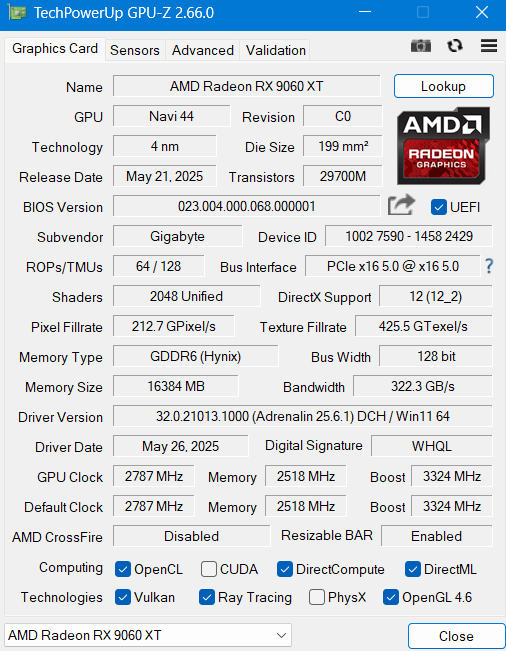

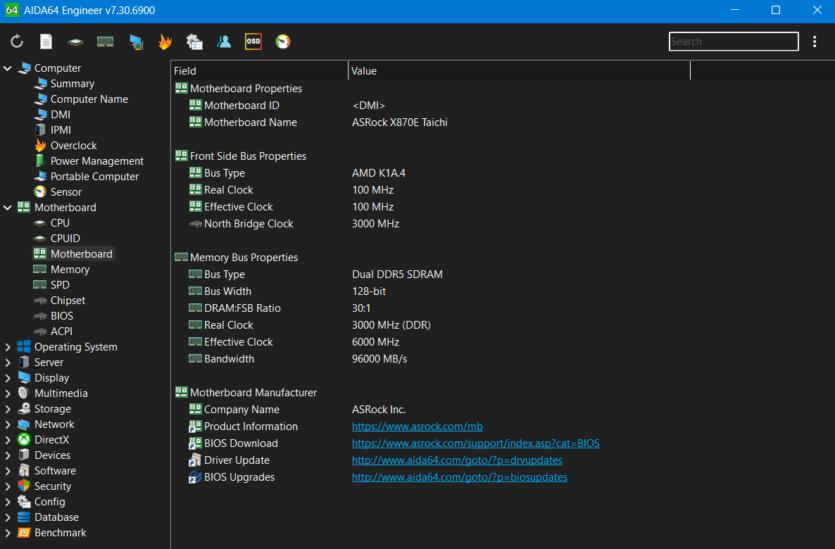
| Interface | PCI-E Gen 5 x16 |
| Technical process | 4 nm |
| Graphics processor | Navi 44 |
| Memory bandwidth | 20 GB/s |
| VRAM capacity | 16GB GDDR6 (Hynix) |
| Memory bus | 128-bit |
| Streaming processors | 2048 |
| Exits | 2 x DisplayPort v2.1a |
| 1 x HDMI v2.1b | |
| Power connector | 1 x 8-pin |
| Energy consumption | 160 W |
| Recommended power supply | 450 W |
| Additionally | WINDFORCE cooling system |
| Dimensions | 281 x 118 x 40 mm |
| Weight | 814 grams |
| Takes up space | 2 slots |
Test bench
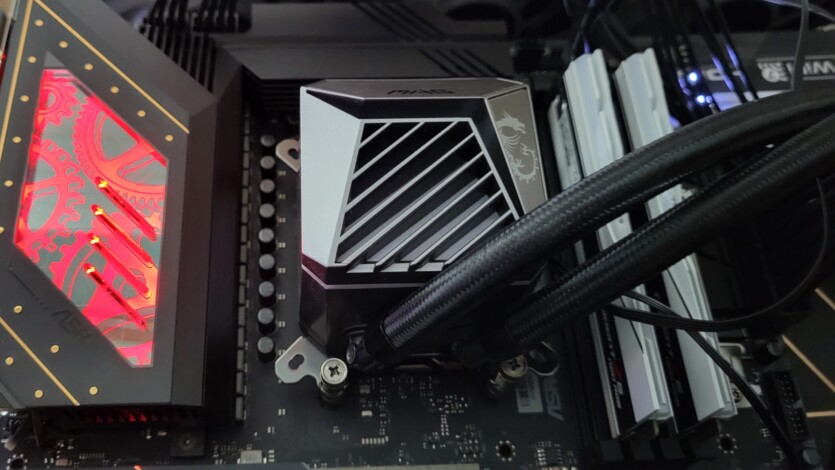
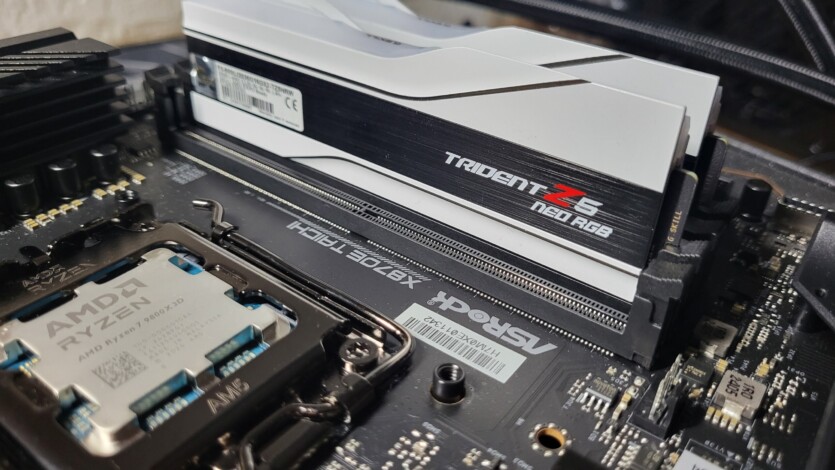

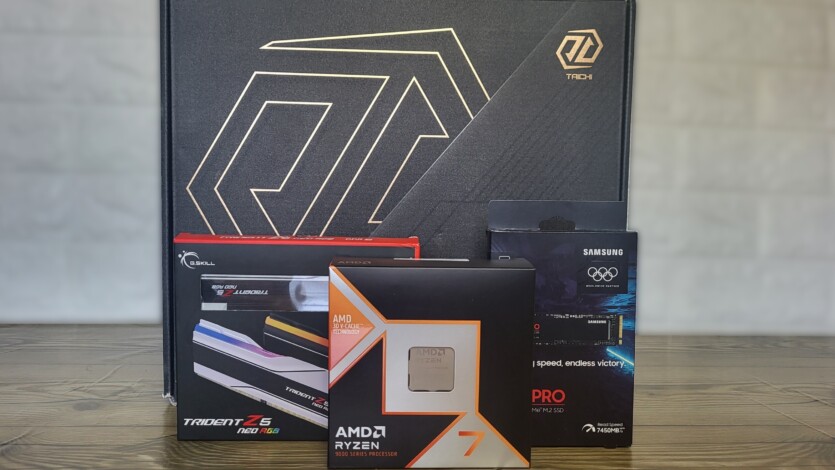
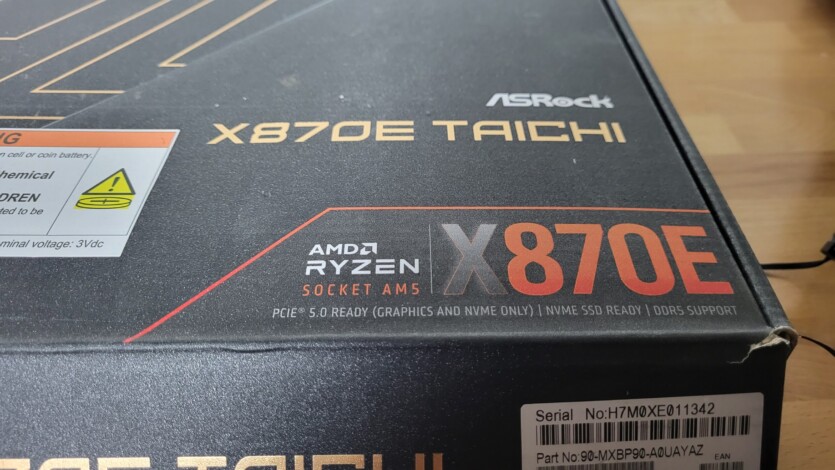
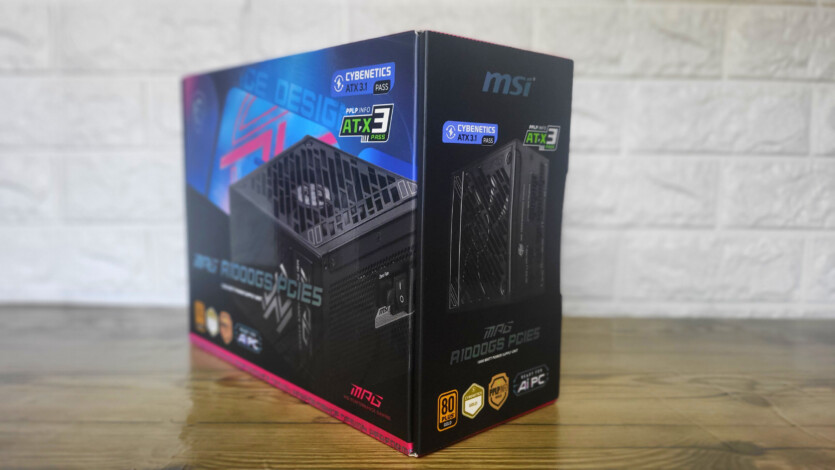
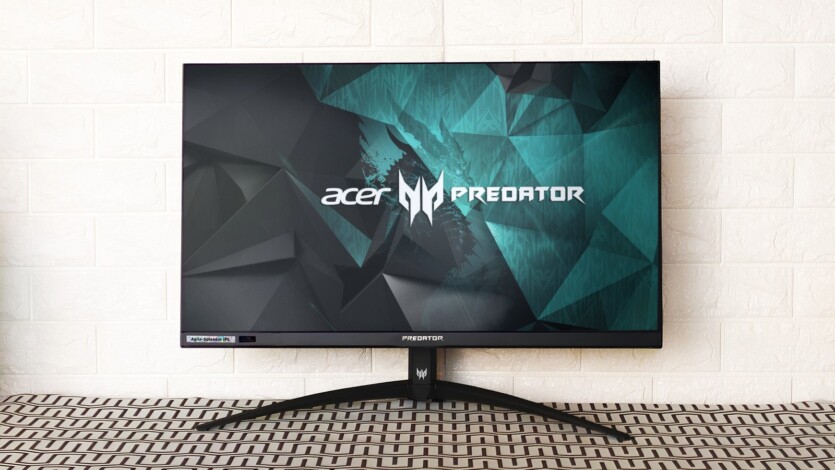
The Gigabyte Radeon RX 9060 XT GAMING OC 16G was tested based on the AM5 platform with the Ryzen 7 9800X 3D processor, which boasts an excellent level of performance for most gamers.
System configuration:
- Motherboard ASRock X870E Taichi;
- Processor AMD Ryzen 7 9800X3D;
- Cooling MSI MAG CORELIQUID A15 360;
- Drive Kingston FURY Renegade 3D NAND TLC 4TB;
- RAM G.Skill DDR5 32GB Trident Z5 Neo RGB;
- Power supplyMSI MPG GS 850W;
- Monitor Acer Predator XB273UV3bmiiprx.
Package, appearance and cooling of Gigabyte Radeon RX 9060 XT GAMING OC 16G
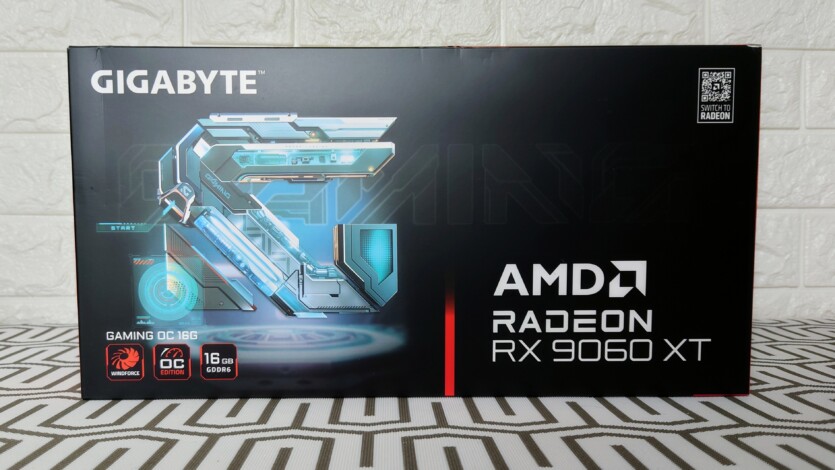
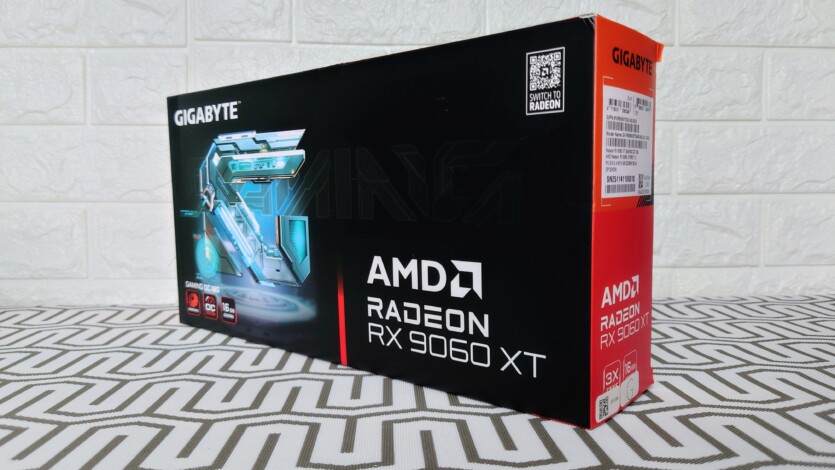




Gigabyte Radeon RX 9060 XT GAMING OC 16G arrived in a nice box that combines AMD’s red and black color scheme with GAMING series design elements. On the box, you can read basic information and technical features of the product.
In addition to the video card, you will find a short user manual. The package is quite standard, with no additional accessories or bonuses.
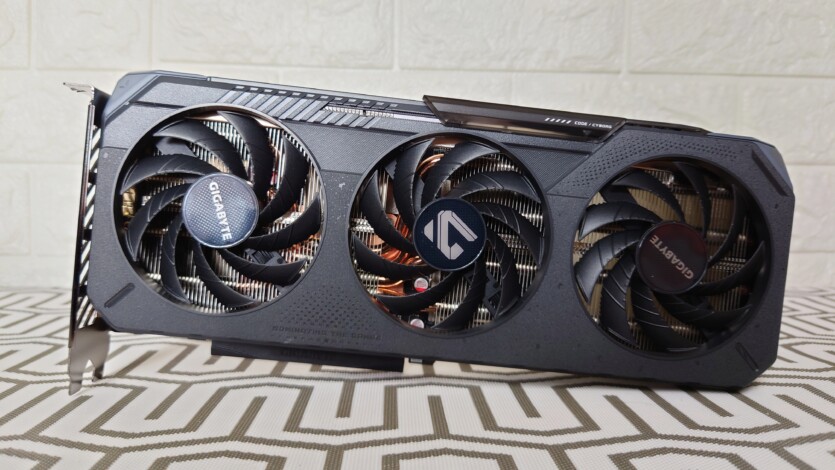
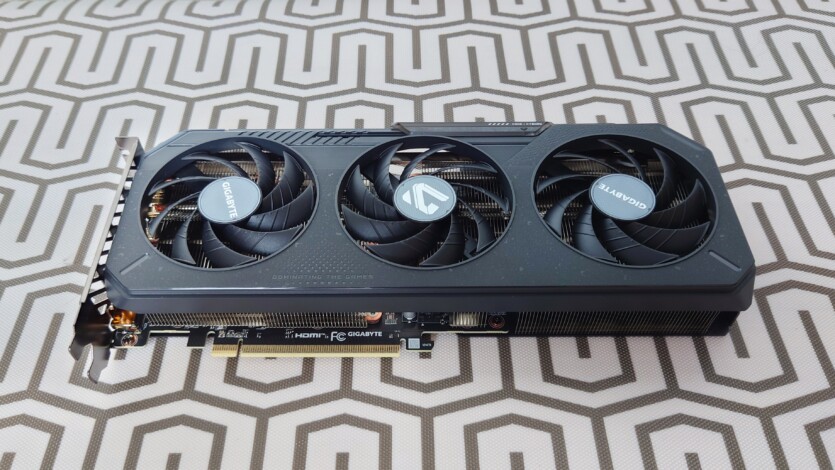

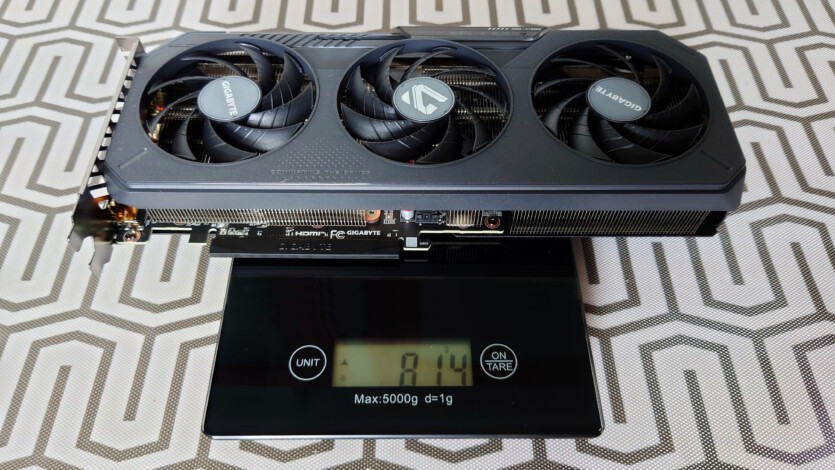
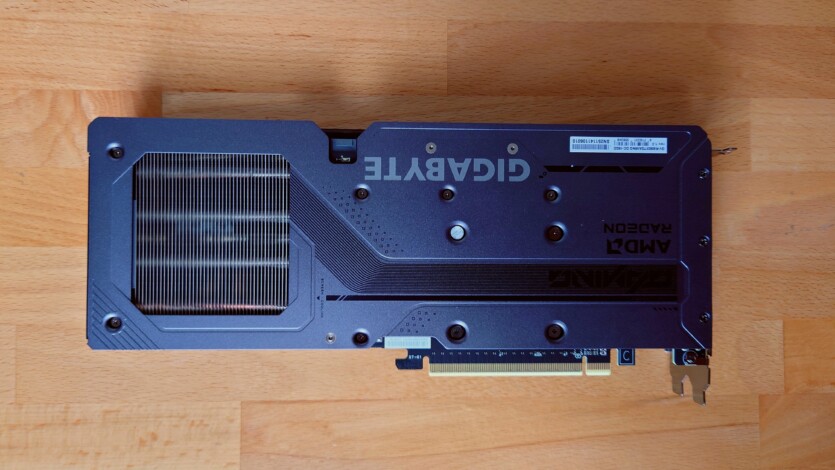

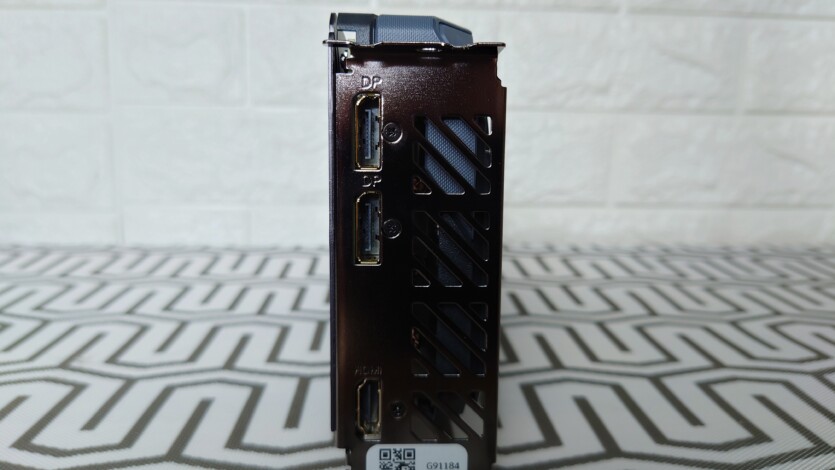
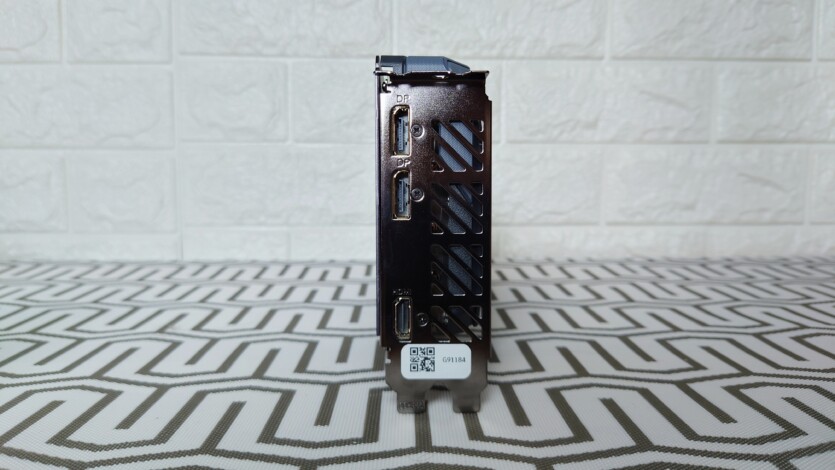
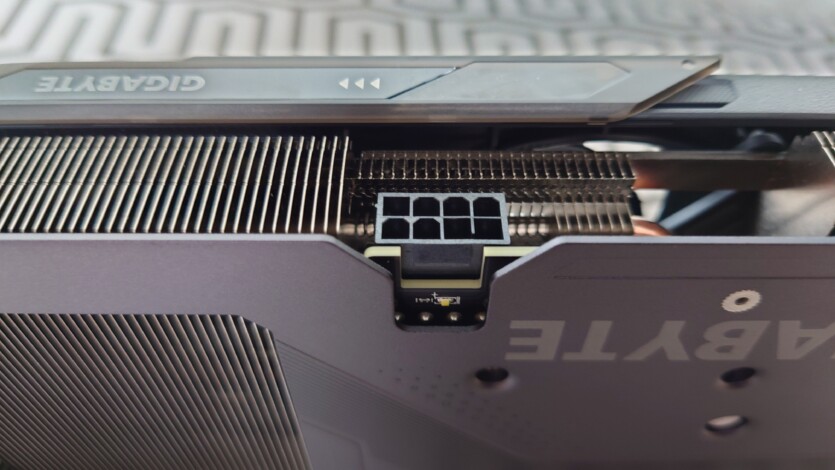
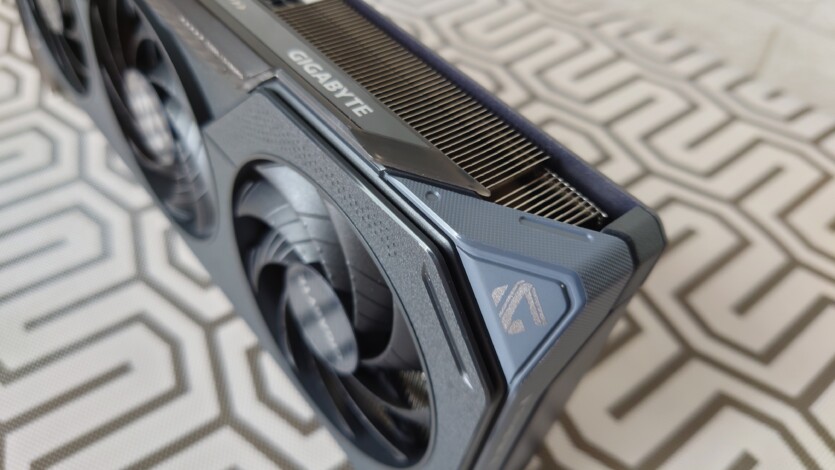
The card looks stylish, but without being too aggressive. The design is made in dark colors with gray accents, and the cooling system shroud has a Gigabyte logo with RGB backlighting that can be customized through the proprietary software. The card measures 281 mm long, 118 mm wide and 40 mm thick. Power is supplied via an eight-pin connector.
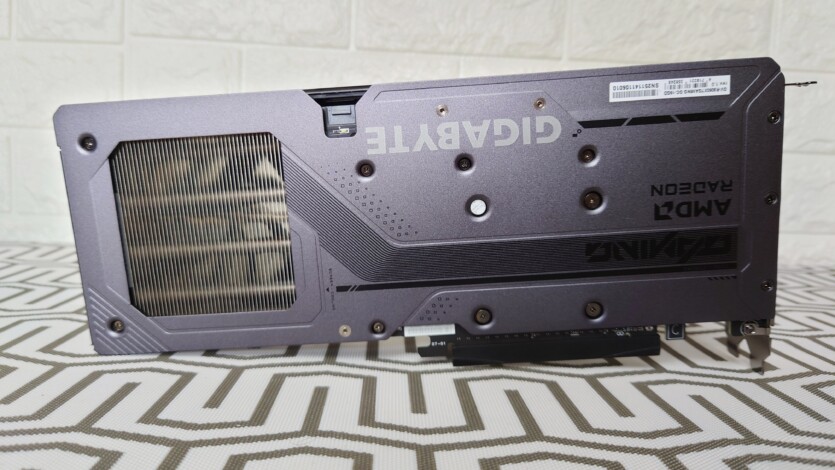


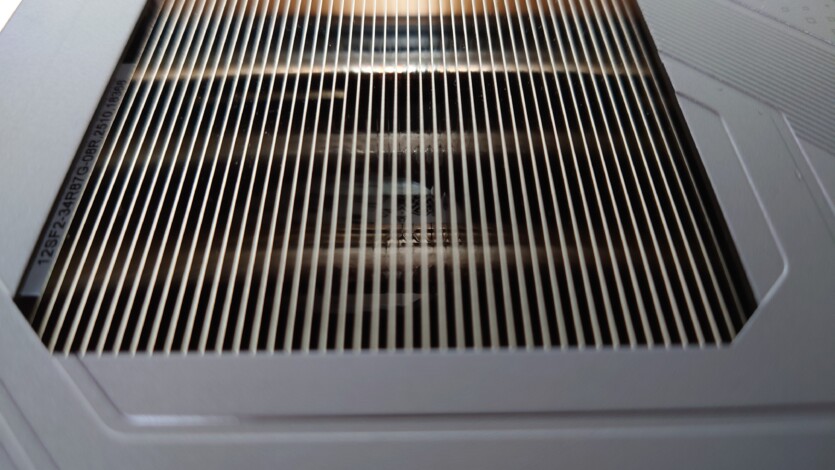
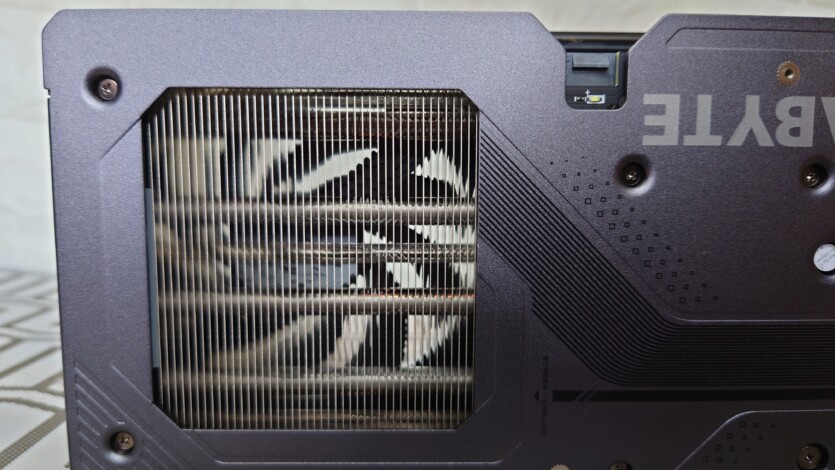

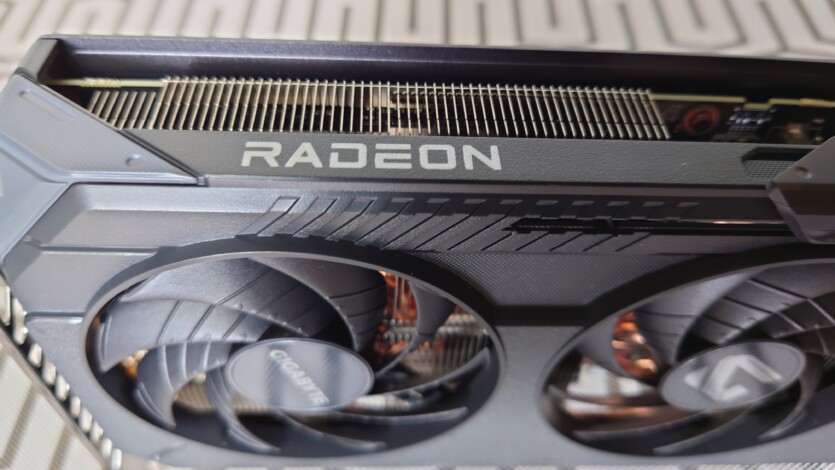
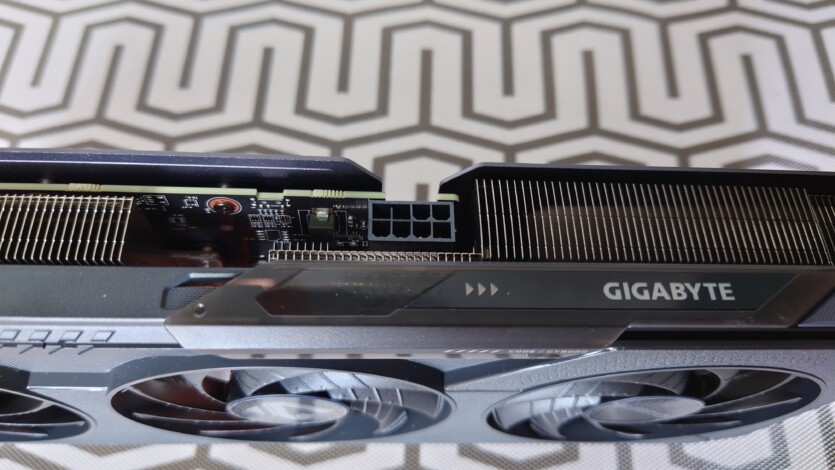


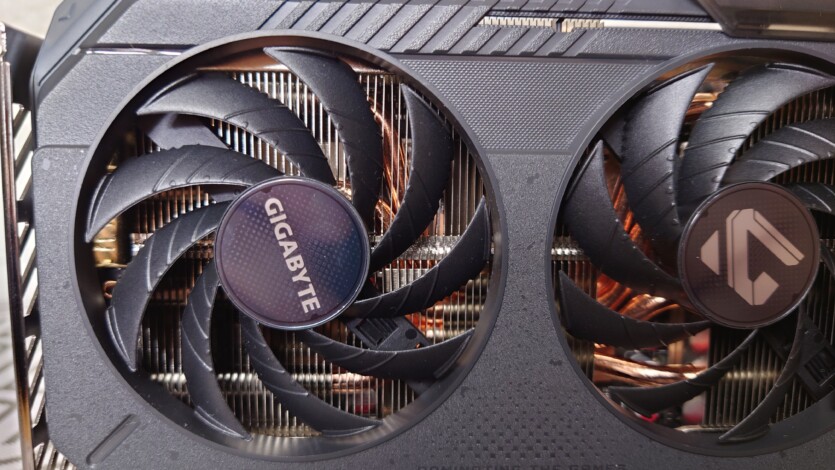
The WINDFORCE cooling system removes heat from the GPU and memory. It consists of three Hawk fans with a diameter of 90 mm. The radiator is pierced by several heat pipes that are in contact with the graphics chip through a copper base. It uses server-grade heat transfer gel. The fans operate in a semi-active mode, meaning they stop when the load is low, which reduces noise during idle time. The design looks sturdy and the build quality is excellent.
Performance and architecture
The Gigabyte Radeon RX 9060 XT GAMING OC 16G is based on AMD’s RDNA 4 architecture, namely the Navi 44 core manufactured using the N4P FinFET process. It contains 2048 stream processors, 128 texture units, and 64 rasterization units, which is the same as the previous model — RX 7600 XTHowever, the key feature is a significant increase in the number of transistors – there are 28.1 billion of them compared to 13.3 billion in Navi 33. The crystal area remained almost the same as its predecessor — 199 mm² vs. 204 mm².
The Navi 44 core has 32 third-generation ray tracing accelerators that provide improved performance in raytracing games. In addition, the card is equipped with 64 second-generation AI cores, which, according to AMD, are twice as fast as their predecessors in ray tracing tasks and eight times faster in artificial intelligence processing. This opens up new possibilities for image scaling technologies. As for performance: in game mode, the frequency is 2780 MHz, and in boost mode it automatically increases to 3320 MHz, compared to the reference 3130 MHz.
The GDDR6 memory operates at 20.1 GT/s via a 128-bit bus, which is slightly faster than previous models. The memory capacity is 16 GB, which is not only suitable for modern games in 1440p resolution, but also gives hope for some «margin for the future». Although AMD also offers a controversial 8GB variant for users with lower requirements, such as Full HD.
| Radeon RX 9600 XT | Radeon RX 7600 XT | GeForce RTX 5060 Ti | GeForce RTX 4060 Ti | |
| Release date | Jun 5, 2025 | Jan 24, 2024 | April 16, 2025 | May 24, 2023 |
| Technical process | TSMC N4P | TSMC N6 | TSMC 4N | TSMC 4N |
| Crystal area (mm²) | 199 mm² | 204 mm² | 181 mm² | 187.8 mm² |
| Kernel configuration: | 2048 : 128 : 64 | 2048 : 128 : 64 | 4608 : 144 : 48 | 4352 : 136 : 48 |
| GPU frequency (reference / boost) | 3130/3320 MHz | 2755 MHz | 2572 MHz | 2540 MHz |
| Memory capacity | 16 GB | 16 GB | 8 GB / 16 GB | 8 GB / 16 GB |
| Memory speed | 20 Gbps | 18 Gbps | 28 Gbps | 18 Gbps |
| Memory type | GDDR6 | GDDR6 | GDDR7 | GDDR6 |
| Bit capacity / bus bandwidth | 128-bit, 320 GB/s | 128-bit, 288 GB/s | 128-bit, 448 GB/s | 128-bit, 288 GB/s |
| PCIe interface | PCIe 5.0 x16 | PCIe 4.0 x8 | PCIe 5.0 x8 | PCIe 4.0 x8 |
| Energy consumption | 160W | 190 W | 180 W | 160 W |
The card has improved support for H.264, HEVC, and AV1 codecs, making it a must-have for streamers and content creators. Blender is poorly optimized for AMD’s architecture, so don’t expect great results here. Even the RTX 5060 is more than twice as fast in this discipline. However, a representative of the «green camp» could not generate 10 images in high quality in Amuse and would crash. In turn The Gigabyte Radeon RX 9060 XT GAMING OC 16G does an excellent job with this task thanks to 16 gigabytes of video memory. And its result is almost the same as the NVIDIA Geforce RTX 5060 Ti. Therefore, AMD seems to be a reasonable choice for working with offline generation.
However, a representative of the «green camp» could not generate 10 images in high quality in Amuse and would crash. In turn The Gigabyte Radeon RX 9060 XT GAMING OC 16G does an excellent job with this task thanks to 16 gigabytes of video memory. And its result is almost the same as the NVIDIA Geforce RTX 5060 Ti. Therefore, AMD seems to be a reasonable choice for working with offline generation.



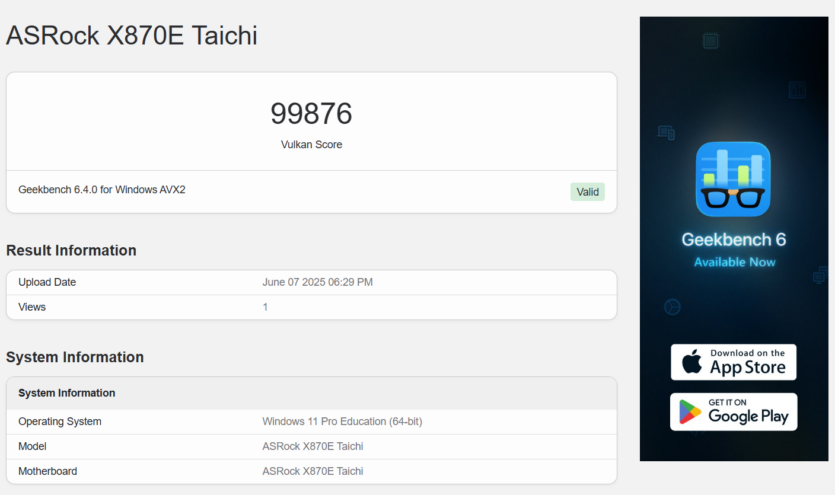
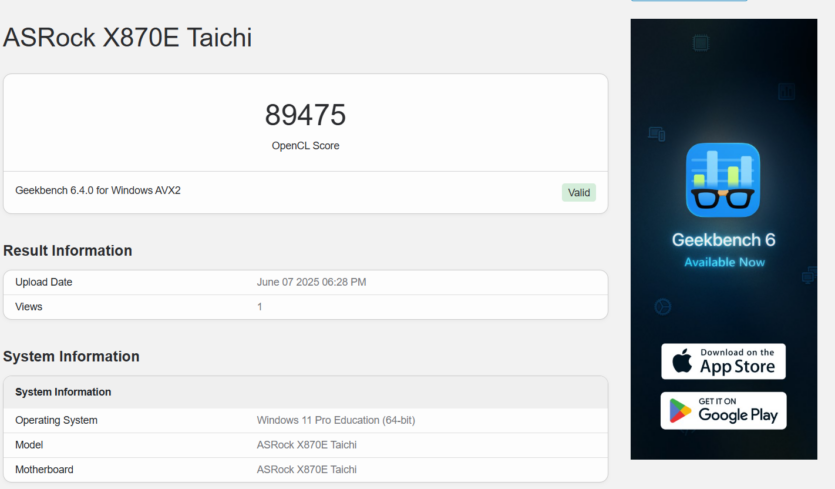
Realistic Interior Lightning crashed with a driver error about halfway through rendering. We attribute this to insufficient optimization by the software developers.
Gigabyte Radeon RX 9060 XT GAMING OC 16G gaming performance
And the most important thing that gamers are interested in in this review is the gaming performance of RX 9060 XT. Here, first of all, it is worth noting that you need to look not just at the dry numbers «on paper», but at the real picture of the gameplay. The number of frames per second and the quality of these frames are two different things. It is as if you are traveling in different cars at the same speed, but depending on the brand and class, the ride will be completely different.  В S.T.A.L.K.E.R. 2 Gigabyte Radeon RX 9060 XT GAMING OC 16G’s pure performance without the help of a frame generator and supersampling is 5-7% better than RTX 5060. But you are unlikely to want to play QHD games at — 46 fps.
В S.T.A.L.K.E.R. 2 Gigabyte Radeon RX 9060 XT GAMING OC 16G’s pure performance without the help of a frame generator and supersampling is 5-7% better than RTX 5060. But you are unlikely to want to play QHD games at — 46 fps.
Therefore, with FG plus FSR enabled, we get 114 frames per second. This is 23% more than RTX 5060 and 14% more than RTX 5060 Ti. And this is the case when the advantage in framerate does not make any practical sense, because the picture is very «soapbox».
To the credit of the developers, the unpleasant lag that we observed in previous tests has disappeared Gigabyte Radeon RX 9070 XT AORUS ELITE and GIGABYTE Radeon RX 9070 GAMING OC. At that time, turning on the frame generator caused an unpleasant delay in the gameplay. This time it is not there.
When researching the Exclusion Zone, I recommend using Intel XeSS supersampling. The picture becomes clearer than in FSR, and at QuadHD we get about 100 frames per second on the screen. With these quality settings, playing S.T.A.L.K.E.R. 2 is the most comfortable
 В Indiana Jones and the Great Circle a similar situation is observed. Only here is Gigabyte Radeon RX 9060 XT GAMING OC 16G inferior in pure performance to its NVIDIA opponents by 4 to 6% in QuadHD and by 19-21% in FullHD.The help of the frame generator and FSR changes the situation somewhat. In this case, the AMD video card is 61% faster than the RTX 5060, but 60% slower than the RTX 5060 Ti. This is due to the use of DLSS 4 from NVIDIA That is why there is such a big gap.
В Indiana Jones and the Great Circle a similar situation is observed. Only here is Gigabyte Radeon RX 9060 XT GAMING OC 16G inferior in pure performance to its NVIDIA opponents by 4 to 6% in QuadHD and by 19-21% in FullHD.The help of the frame generator and FSR changes the situation somewhat. In this case, the AMD video card is 61% faster than the RTX 5060, but 60% slower than the RTX 5060 Ti. This is due to the use of DLSS 4 from NVIDIA That is why there is such a big gap.
And again, by analogy with S.T.A.L.K.E.R. 2, we turn on Intel’s Xe SS supersampling. Thus, at QuadHD, we can get 115 frames per second, which provides a pretty nice picture and comfortable gameplay.
 Cyberpunk 2077 remains the strong point of the RX 9060 XT. Indeed, at ultra settings, it outperforms the RTX 5060 by almost two times. It also outperforms NVIDIA RTX 5060 Ti by 72%. But at FullHD without the help of neural technology, the Gigabyte Radeon RX 9060 XT GAMING OC 16G is on the contrary 9% slower than NVIDIA RTX 5060 and 17% slower than the NVIDIA RTX 5060 Ti.
Cyberpunk 2077 remains the strong point of the RX 9060 XT. Indeed, at ultra settings, it outperforms the RTX 5060 by almost two times. It also outperforms NVIDIA RTX 5060 Ti by 72%. But at FullHD without the help of neural technology, the Gigabyte Radeon RX 9060 XT GAMING OC 16G is on the contrary 9% slower than NVIDIA RTX 5060 and 17% slower than the NVIDIA RTX 5060 Ti.  В Silent Hill 2 the net performance result at QuadHD using FSR shows almost the same result as in NVIDIA RTX 5060. In QuadHD, the video card is close to NVIDIA RTX 5060 Ti.
В Silent Hill 2 the net performance result at QuadHD using FSR shows almost the same result as in NVIDIA RTX 5060. In QuadHD, the video card is close to NVIDIA RTX 5060 Ti.
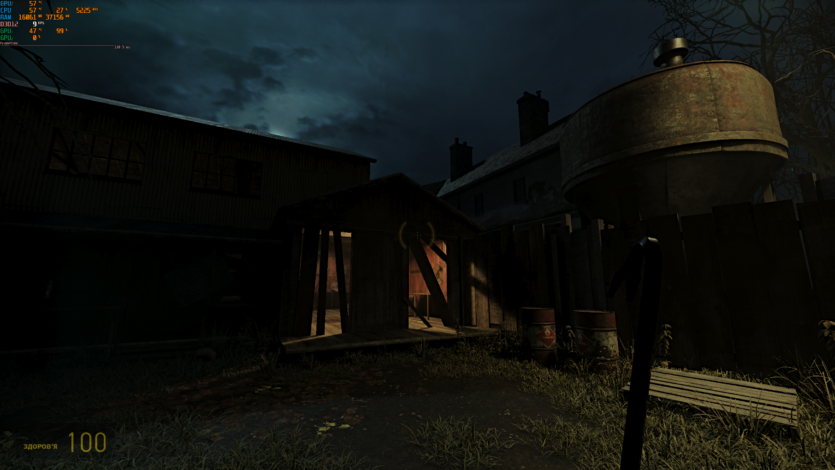
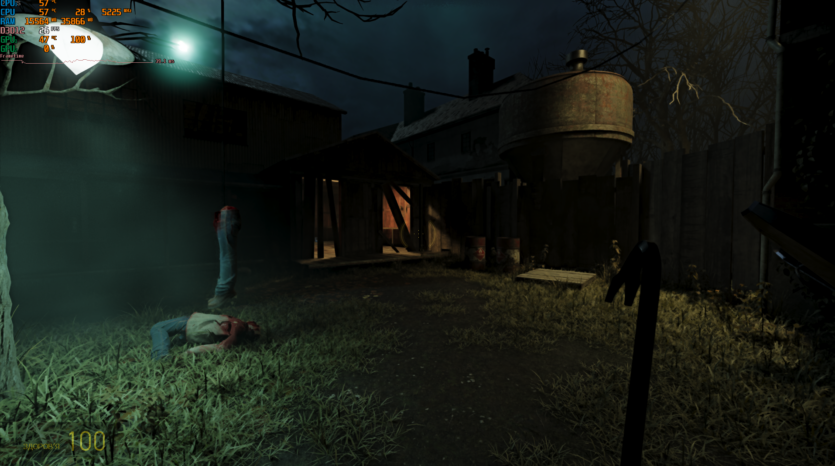
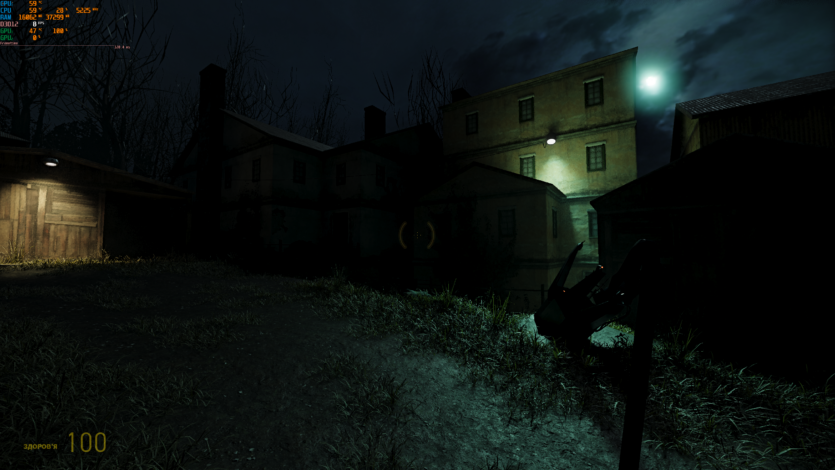
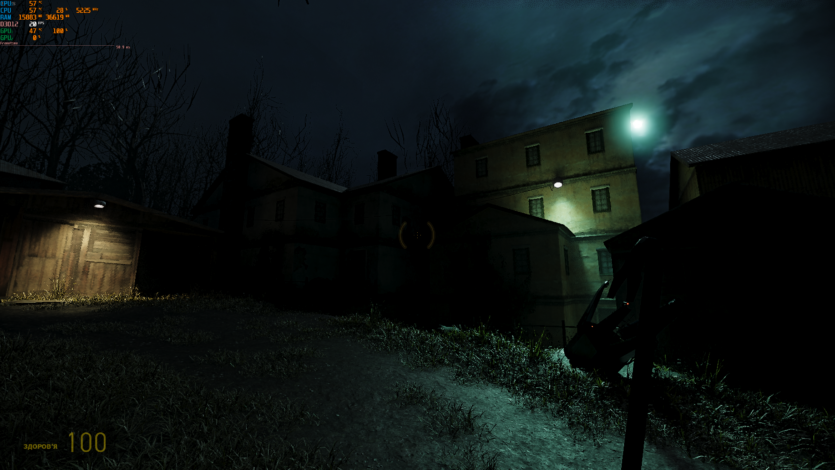

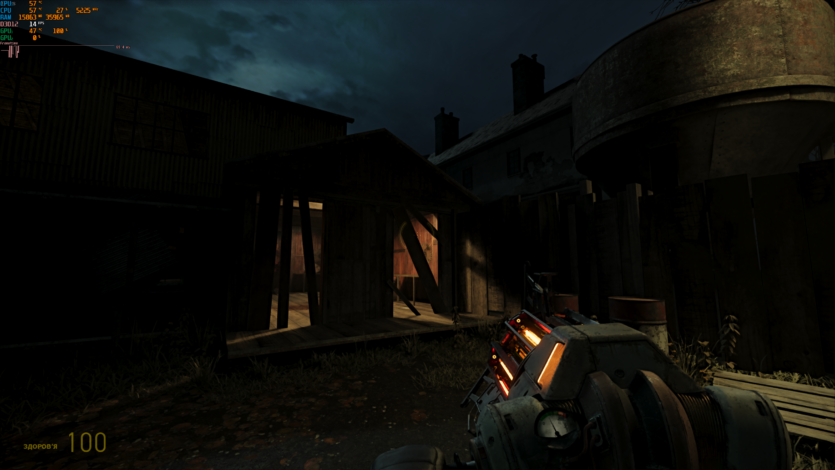
It has long been known that Half-Life 2 RTX is still «raw», so it is very difficult to expect objective results from it. The performance table here looks very strange, because this game is not optimized for Intel and AMD graphics cards at all. It supports only NVIDIA’s DLSS and two native upscalers, which produce a terrible picture with unpleasant graphics.
So listen to the old saying: «Don’t go to Ravenholm». So far, it’s not comfortable to play Half-Life 2 RTX on AMD graphics cards. Perhaps it’s worth waiting until the game comes out of beta and finally learns to work with all the modern neural technologies closer to its release
 A Plague Tale Requiem does not support FSR and frame generator, so there are some difficulties with this game on AMD video cards. If older models like Gigabyte Radeon RX 9070 XT AORUS ELITE are getting out of the way thanks to their high rasterization performance, the less powerful versions can no longer cope with it on their own.
A Plague Tale Requiem does not support FSR and frame generator, so there are some difficulties with this game on AMD video cards. If older models like Gigabyte Radeon RX 9070 XT AORUS ELITE are getting out of the way thanks to their high rasterization performance, the less powerful versions can no longer cope with it on their own.
You don’t have to crank up the settings in the non-Epic preset. Move the «settings to the left» to high without tracing and get comfortable gameplay at up to 80 frames per second.
 And here Oblivion has been perfectly optimized for the Gigabyte Radeon RX 9060 XT GAMING OC 16G. It outperforms NVIDIA graphics cards by 24 to 67%, depending on the selected settings. The picture looks rich and clear. The result is good detail and enjoyable gameplay.
And here Oblivion has been perfectly optimized for the Gigabyte Radeon RX 9060 XT GAMING OC 16G. It outperforms NVIDIA graphics cards by 24 to 67%, depending on the selected settings. The picture looks rich and clear. The result is good detail and enjoyable gameplay.
At the same time, the video card consumes more than 8 gigabytes of video memory. It is for this reason that NVIDIA The RTX 5060 sagged significantly. The Gigabyte Radeon RX 9060 XT GAMING OC 16G, in turn, comes out on top.
 The French annihilator of free time — Clair Obscur: Expedition 33 works great on the RX 9060 XT. The difference with the RTX 5060 is from 1 to 7% depending on the selected settings. Unfortunately, this game does not support FSR. However, we can use XeSS — 67%, having received an acceptable number of frames to respond in time to attacks from powerful and insidious bosses
The French annihilator of free time — Clair Obscur: Expedition 33 works great on the RX 9060 XT. The difference with the RTX 5060 is from 1 to 7% depending on the selected settings. Unfortunately, this game does not support FSR. However, we can use XeSS — 67%, having received an acceptable number of frames to respond in time to attacks from powerful and insidious bosses Doom: The Dark Ages sided with the «red» side, which is not surprising given its lor. Gigabyte Radeon RX 9060 XT GAMING OC 16G is 46% faster than NVIDIA RTX 5060 if you enable neurotechnology. The reason is simple — 8 GB of video memory is increasingly not enough in modern gaming at QuadHD. But at FullHD, the RTX 5060 comes out ahead by 26%.
Doom: The Dark Ages sided with the «red» side, which is not surprising given its lor. Gigabyte Radeon RX 9060 XT GAMING OC 16G is 46% faster than NVIDIA RTX 5060 if you enable neurotechnology. The reason is simple — 8 GB of video memory is increasingly not enough in modern gaming at QuadHD. But at FullHD, the RTX 5060 comes out ahead by 26%. 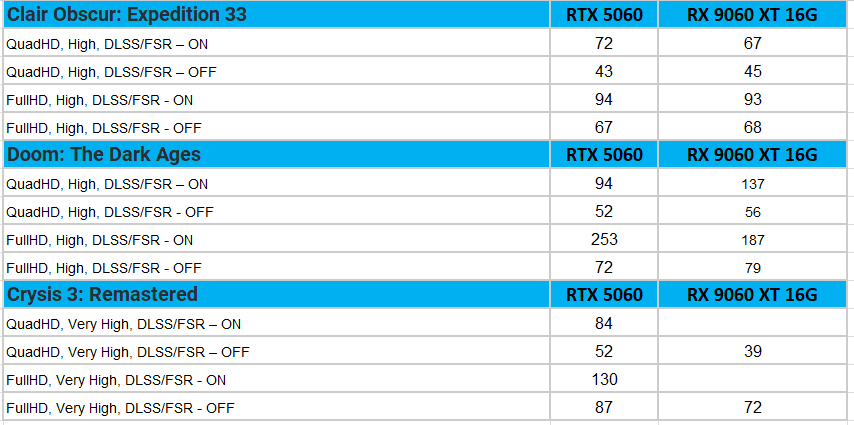 Fully check the video card in Crysis 3 Remastered. It didn’t work out. Or rather, it worked by 50%, because it does not support FSR technology. Therefore, I had to run it only using regular rasterization without any help from upscalers. Ray tracing technologies put a lot of strain on the video card. That’s why we get 39 frames at QuadHD and 72 frames per second at FullHD.
Fully check the video card in Crysis 3 Remastered. It didn’t work out. Or rather, it worked by 50%, because it does not support FSR technology. Therefore, I had to run it only using regular rasterization without any help from upscalers. Ray tracing technologies put a lot of strain on the video card. That’s why we get 39 frames at QuadHD and 72 frames per second at FullHD.

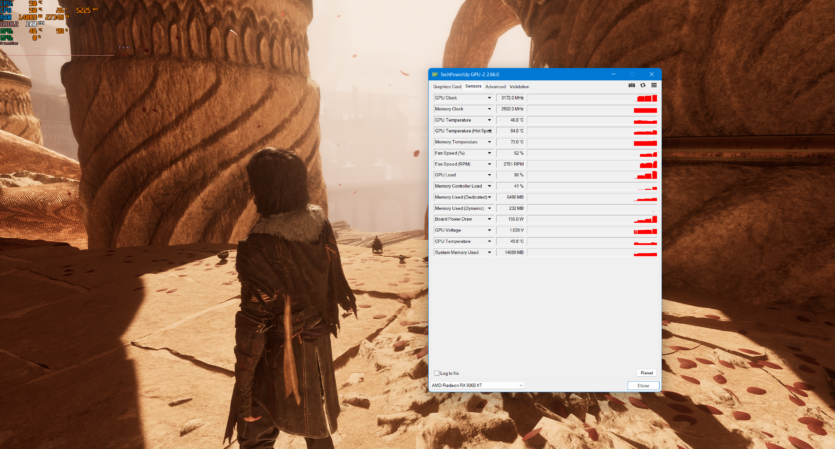

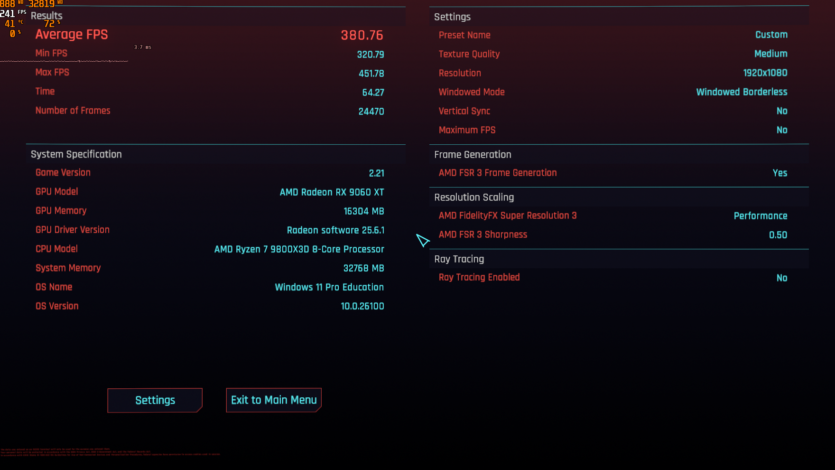


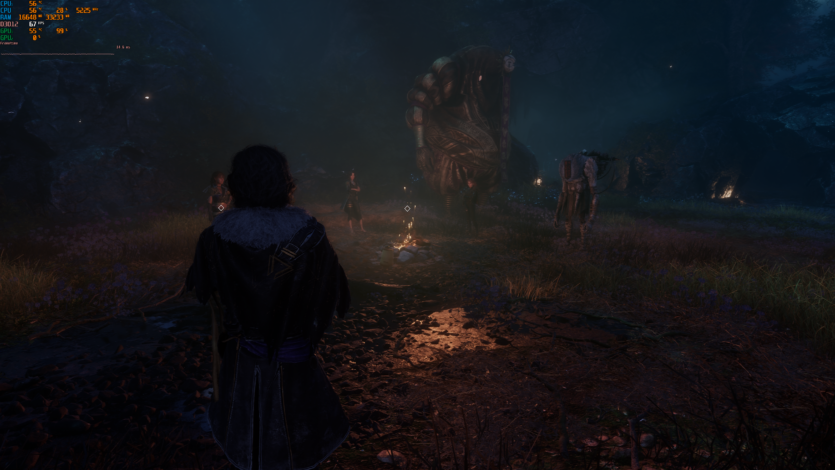



To achieve the coveted 60+ fps, we set the settings to high and medium raytracing. This way we can join the immortal classics.
Power consumption, noise and heat of the Gigabyte Radeon RX 9060XT GAMING OC 16G
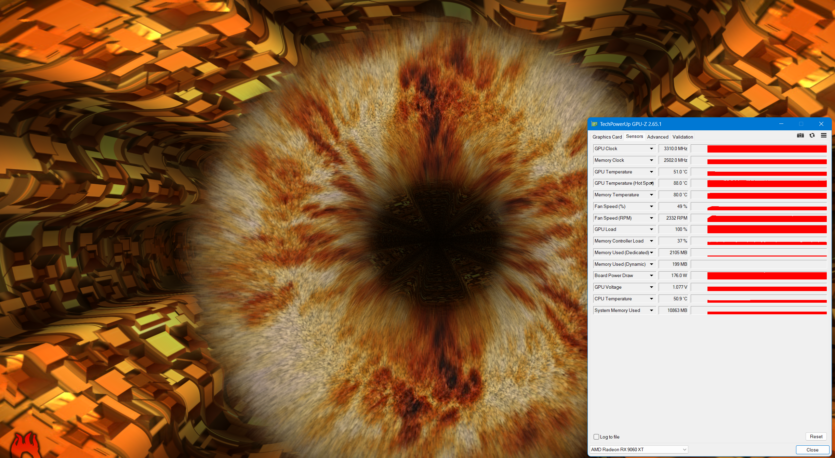

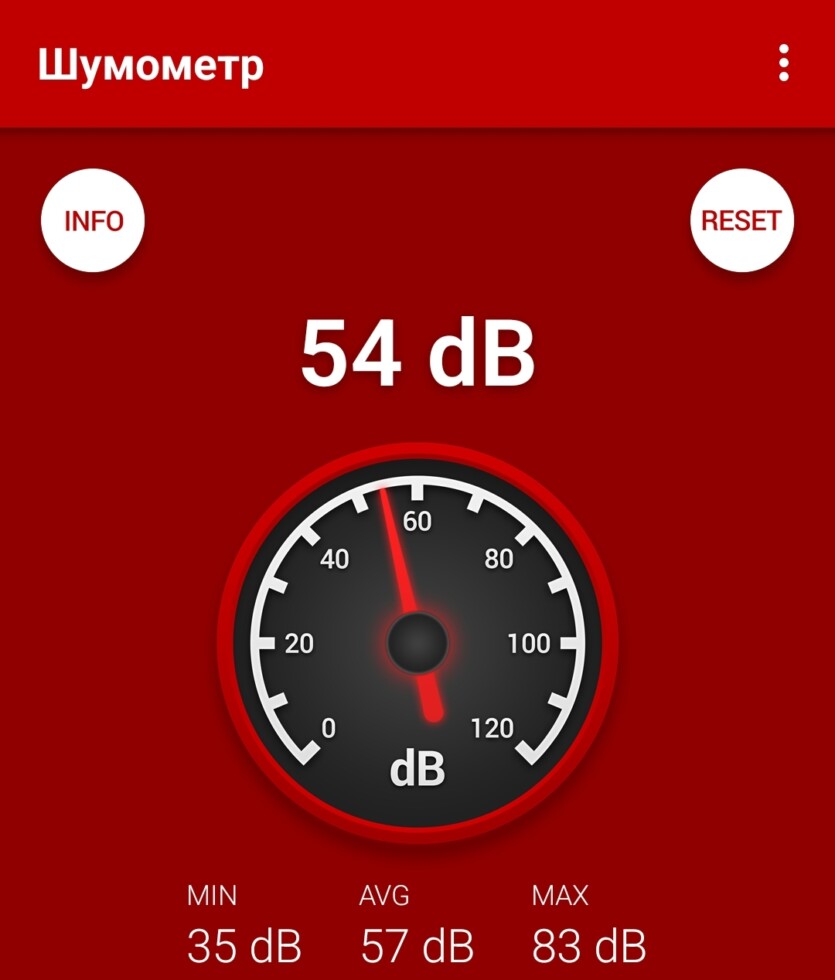
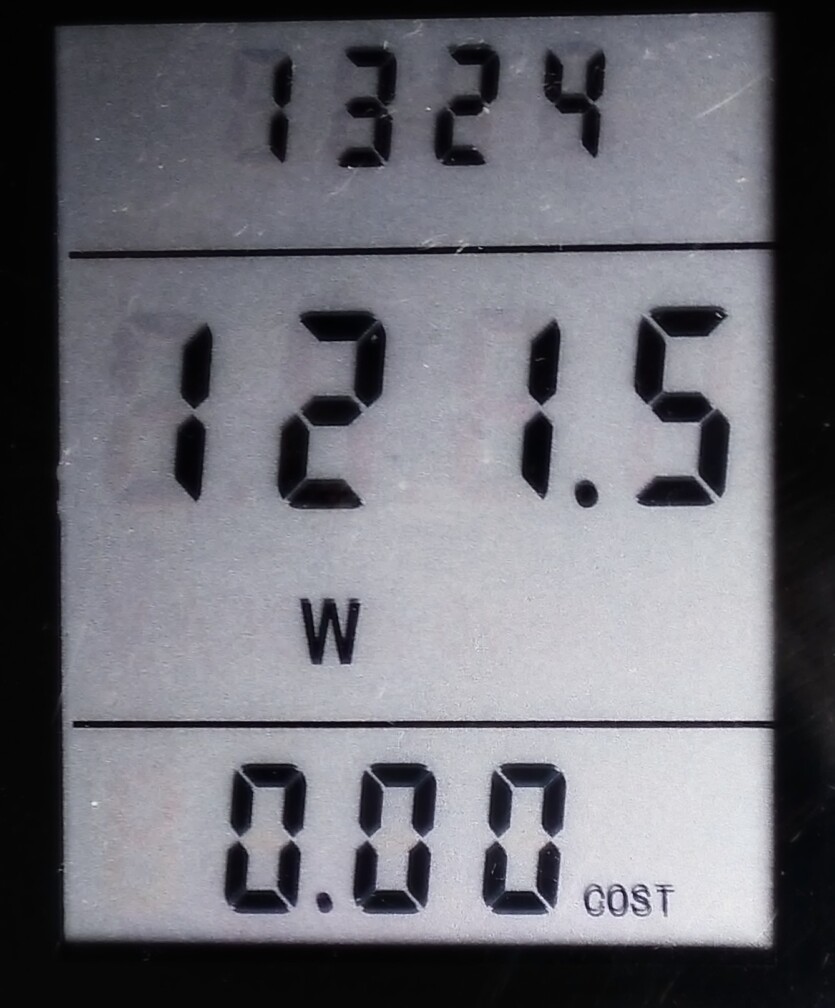
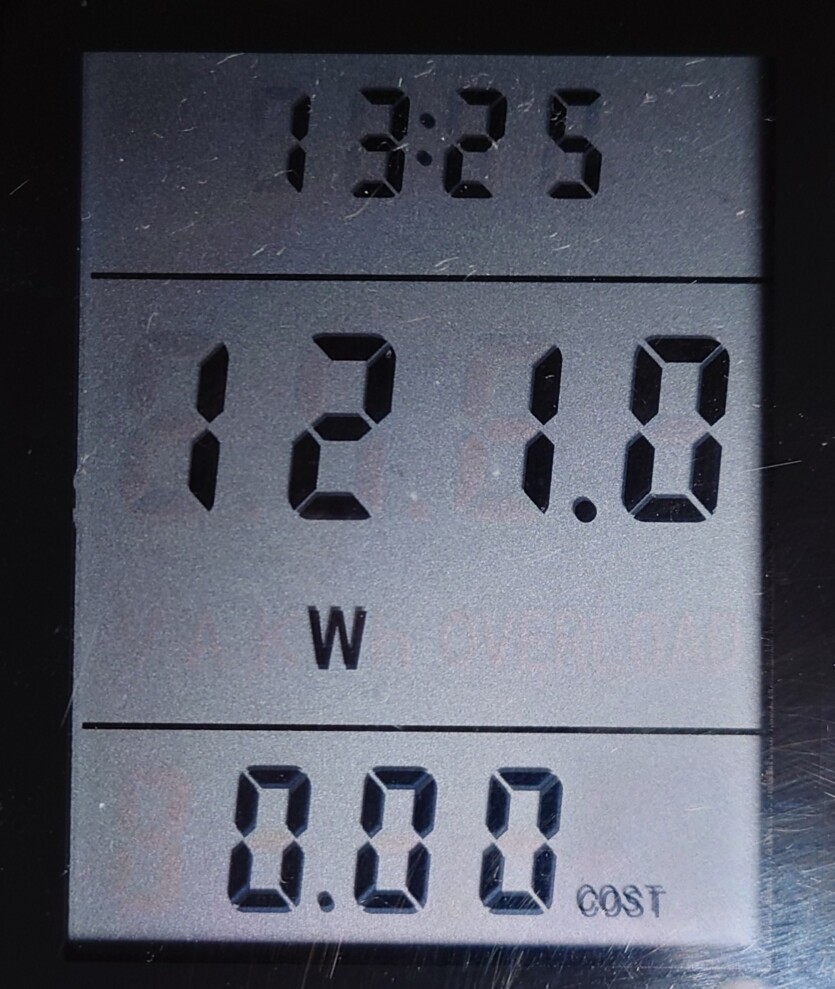
The power consumption of the card is 180 W under load. The idle mode raises questions. GPU-Z says that on a desktop Gigabyte Radeon RX 9060 XT GAMING OC 16G consumes 28 watts, but the power meter shows as much as 44 watts, which is a lot. A 450-500W power supply will be enough for stable operation. The entire system consumed no more than 320 watts at its peak.
In terms of noise, the WINDFORCE cooling system is quite quiet when idle due to the fans stopping. But under load, the video card resembles a Boeing on the way out. At such moments, the sound level meter recorded 50 dB at a distance of one meter.
The temperature of the GPU during long gaming sessions is kept within 65-75°C, but during maximum stress tests you can see 80°C (hotspot) and 88°C in memory. As practice shows, it is quite difficult to remove heat from the new generation of AMD video cards. The blown air is not hot — only 36°C, and the backplane — 47°C. Of course, temperatures will be lower in the cold season.
Experience of use
In the test bench and in my gaming leisure time over the past months, I have used Gigabyte Radeon RX 9070 XT AORUS ELITE. Therefore, I have already experienced all the pros and cons of the new generation. Like the older models, Gigabyte Radeon RX 9060 XT GAMING OC 16G has some «childhood diseases». First of all, these are the temperatures of the hottest point and memory.
As you can see, even heat-conducting gels don’t make much of a difference. I’m a fan of «icy» graphics cards, so to speak, «with a margin of», although my mining experience shows that there is nothing wrong with temperatures of 80-85°C and equipment can operate in this mode for years without any problems.
In general, Gigabyte Radeon RX 9060 XT GAMING OC 16G has high potential and a lot of potential for the future. The main problem at this time is that software and game developers should implement support for not only DLSS, but also FSR and XeSS as often as possible. This will ultimately benefit all consumers.
Prices and competitors
Standing out from the competition Gigabyte Radeon RX 9060 XT GAMING OC 16G costs exactly as much as it needs to for its place in the market — no more, no less. It is available now at a price starting at UAH 21,989.  If this amount seems too high and FullHD is enough for you, like most gamers according to Steam statistics, you can look in the direction of MSI GeForce RTX 5060 8G GAMING OC which costs 4,500 hryvnias less, or even Sparkle Intel Arc B580 TITAN OC.
If this amount seems too high and FullHD is enough for you, like most gamers according to Steam statistics, you can look in the direction of MSI GeForce RTX 5060 8G GAMING OC which costs 4,500 hryvnias less, or even Sparkle Intel Arc B580 TITAN OC.
It boasts 12 Gigabytes of video memory, which allows it to claim to be a budget QuadHD gaming machine with some compromises in settings. And here MSI GeForce RTX 5060 Ti 16G GAMING TRIO OC although more expensive by UAH 5000, has high-speed GDDR7 video memory and a powerful chip — GB206, which, when paired with DLSS4, allow you to encroach even on basic 4K gaming. Therefore, the choice is up to customers.

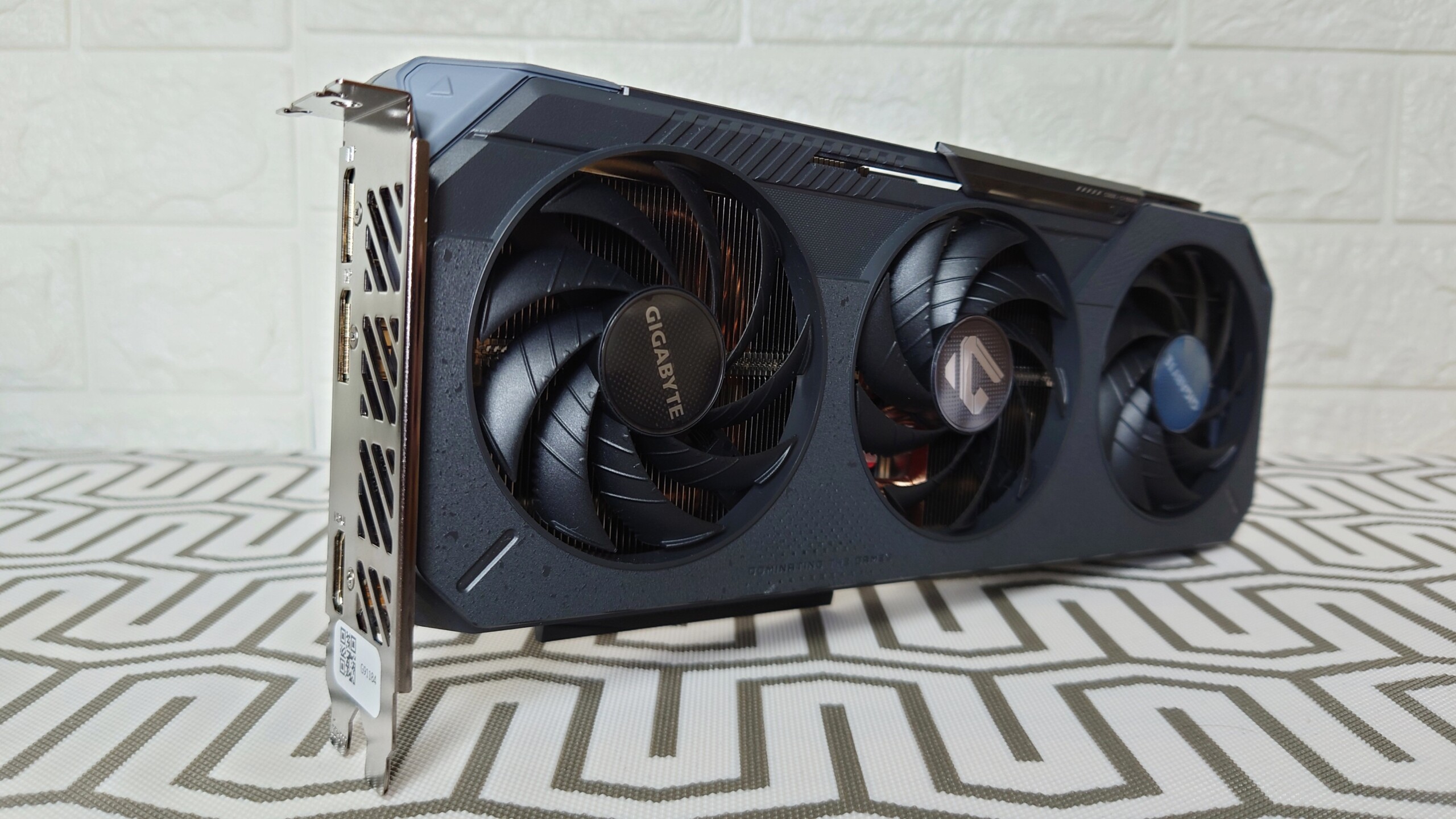
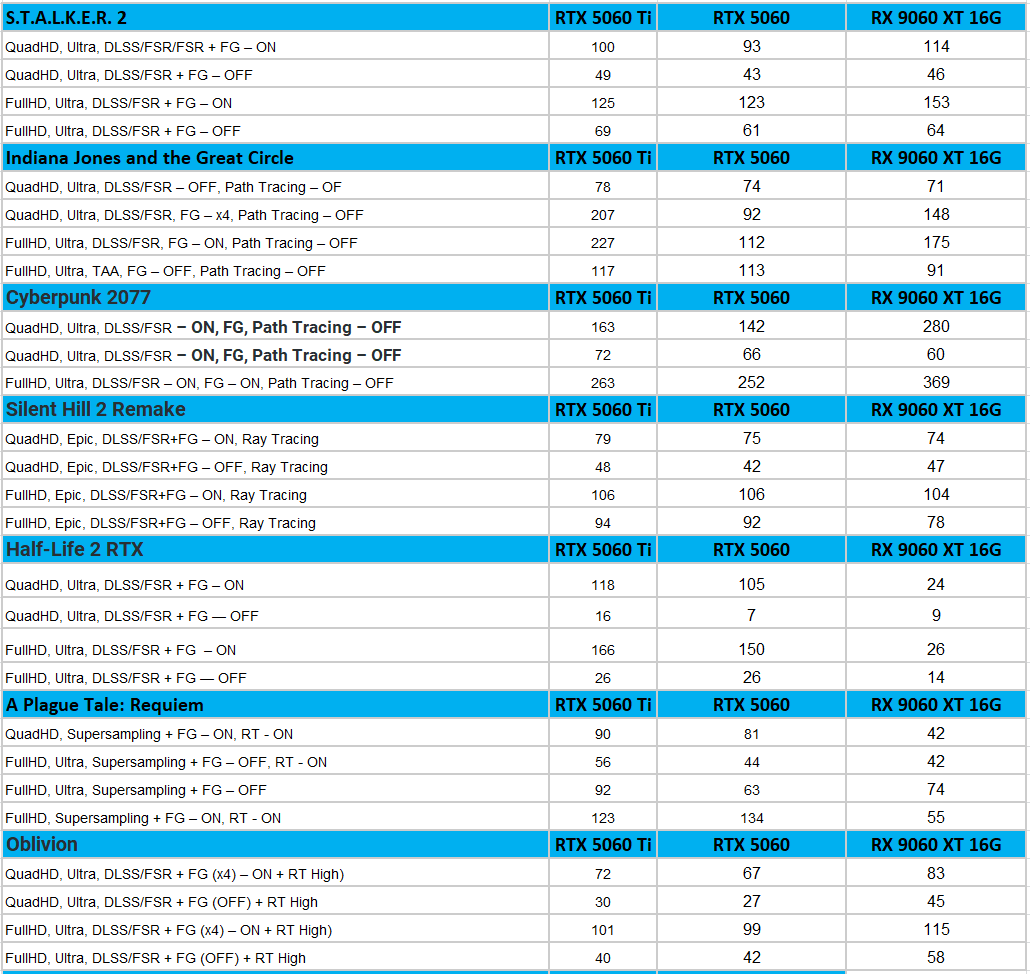

Spelling error report
The following text will be sent to our editors: